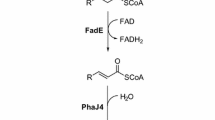Abstract
Cellular eicosapentaenoic acid (EPA) makes up approximately 3% of total fatty acids in Escherichia coli DH5α, a strain that carries EPA biosynthesis genes (pEPAΔ1). EPA was increased to 12% of total fatty acids when the host cell co-expressed the vector pGBM3::sa1(vktA), which carried the high-performance catalase gene, vktA. Where this vector was co-expressed, the transformant accumulated a large amount of VktA protein. However, the EPA production of cells carrying the vector, that included the insert lacking almost the entire vktA gene, was approximately 6%. This suggests that the retention of a large DNA insert in the vector and the accumulation of the resulting protein, but not the catalytic activity of VktA catalase, would potentially be able to increase the content of EPA.



Similar content being viewed by others
References
Allen EE, Bartlett DH (2002) Structure and regulation of the omega-3 polyunsaturated fatty acid synthase genes from the deep-sea bacterium Photobacterium profundum strain SS9. Microbiology 48:1903–1913
Allen EE, Facciotti D, Bartlett DH (1999) Monounsaturated but not polyunsaturated fatty acids are required for growth of the deep-sea bacterium Photobacterium profundum SS9 at high pressure and low temperature. Appl Environ Microbiol 65:1710–1720
Amiri-Jami M, Wang H, Kakuda Y, Griffiths MW (2006) Enhancement of polyunsaturated fatty acid production by Tn5 transposon in Shewanella baltica. Biotechnol Lett 28:1187–1192
Arora KK, Pedersen PL (1995) Glucokinase of Escherichia-coli: induction in response to the stress of overexpressing foreign proteins. Arch Biochem Biophys 319:574–578
Bagdasarian M, Lurz R, Ruckert B, Franklin FC, Bagdasarian MM, Frey J, Timmis KN (1981) Specific-purpose plasmid cloning vectors. II. Broad host range, high copy number, RSF1010-derived vectors, and a host-vector system for gene cloning in Pseudomonas. Gene 16:237–247
Bergé JP, Barnathan G (2005) Fatty acids from lipids of marine organisms: molecular biodiversity, roles as biomarkers, biologically active compounds, and economical aspects. Adv Biochem Eng Biotechnol 96:49–125
Chelikani P, Fita I, Loewen PC (2004) Diversity of structures and properties among catalases. Cell Mol Life Sci 61:192–208
Hauvermale A, Kuner J, Rosenzweig B, Guerra D, Diltz S, Metz JG (2006) Fatty acid production in Schizochytrium sp.: Involvement of a polyunsaturated fatty acid synthase and a type I fatty acid synthase. Lipids 41:739–347
Ichise N (2003) Molecular biological basis and physiological significance of extraordinarily high catalase activity in Vibrio rumoiensis S-1. PhD thesis, Hokkaido University
Ichise N, Morita N, Kawasaki K, Yumoto I, Okuyama H (2000) Gene cloning and expression of the catalase from hydrogen peroxide-resistant bacterium Vibrio rumoiensis S-1 and its subcellular localization. J Biosci Bioeng 90:530–534
Kovach ME, Elzer PH, Hill DS, Robertson GT, Farris MA, Roop RM 2nd, Peterson KM (1995) Four new derivatives of the broad-host-range cloning vector pBBR1MCS, carrying different antibiotic-resistance cassettes. Gene 166:175–176
Kovach ME, Phillips RW, Elzer PH, Roop RM 2nd, Peterson KM (1994) pBBR1MCS: a broad-host-range cloning vector. Bio Techniques 16:800–802
Manen D, Pougeon M, Damay P, Geiselmann J (1997) A sensitive reporter gene system using bacterial luciferase based on a series of plasmid cloning vectors compatible with derivatives of pBR322. Gene 186:197–200
Metz JG, Roessler P, Facciotti D, Levering C, Dittrich F, Lassner N, Valentine R, Lardizabal K, Domergue F, Yamada A, Yazawa K, Knauf V, Browse J (2001) Production of polyunsaturated fatty acids by polyketide synthases in both prokaryotes and eukaryotes. Science 293:290–293
Morita N, Nishida T, Tanaka N, Yano Y, Okuyama H (2005) Enhancement of polyunsaturated fatty acid production by cerulenin treatment in polyunsaturated fatty acid-producing bacteria. Biotechnol Lett 27:389–393
Morita N, Tanaka N, Okuyama H (2000) Biosynthesis of fatty acids in the docosahexaenoic acid-producing bacterium Moritella marina strain MP-1. Biochem Soc Trans 28:943–945
Nishida T, Orikasa Y, Ito Y, Yu R, Yamada A, Watanabe K, Okuyama H (2006a) Escherichia coli engineered to produce eicosapentaenoic acid becomes resistant against oxidative damages. FEBS Lett 580:2731–2735
Nishida T, Orikasa Y, Watanabe K, Okuyama H (2006b) The cell membrane-shielding function of eicosapentaenoic acid for Escherichia coli against exogenously added hydrogen peroxide. FEBS Lett 580:6690–6694
Okuyama H, Orikasa Y, Nishida T, Watanabe K, Morita N (2007) Bacterial genes responsible for the biosynthesis of eicosapentaenoic and docosahexaenoic acids and their heterologous expression. Appl Environ Microbiol (in press). DOI 10.1128/AEM.02270-06
Orikasa Y, Nishida T, Hase A, Watanabe K, Morita N, Okuyama H (2006a) A phosphopantetheinyl transferase gene essential for biosynthesis of n–3 polyunsaturated fatty acids from Moritella marina strain MP-1. FEBS Lett 580:4423–4429
Orikasa Y, Nishida T, Yamada A, Yu R, Watanabe K, Hase A, Morita N, Okuyama H (2006b) Recombinant production of docosahexaenoic acid in a polyketide biosynthesis mode in Escherichia coli. Biotechnol Lett 28:1841–1847
Orikasa Y, Yamada A, Yu R, Ito Y, Nishida T, Yumoto I, Watanabe K, Okuyama H (2004) Characterization of the eicosapentaenoic acid biosynthesis gene cluster from Shewanella sp. strain SCRC-2738. Cell Mol Biol 50:625–630
Ratledge C (2004) Fatty acid biosynthesis in microorganisms being used for single cell oil production. Biochimie 86:807–815
Valentine RC, Valentine DL (2004) Omega-3 fatty acids in cellular membranes: a unified concept. Prog Lipid Res 43:383–402
Yumoto I, Ichihashi D, Iwata H, Istokovics A, Ichise N, Matsuyama H, Okuyama H, Kawasaki K (2000) Purification and characterization of a catalase from the facultatively psychrophilic bacterium Vibrio rumoiensis S-1T exhibiting high catalase activity. J Bacteriol 182:1903–1909
Yumoto I, Iwata H, Sawabe T, Ueno K, Ichise N, Matsuyama H, Okuyama H, Kawasaki K (1999) Characterization of a facultatively psychrophilic bacterium, Vibrio rumoiensis sp. nov., that exhibits high catalase activity. Appl Environ Microbiol 65:67–72
Author information
Authors and Affiliations
Corresponding author
Additional information
An erratum to this article is available at http://dx.doi.org/10.1007/s10529-007-9343-4.
Rights and permissions
About this article
Cite this article
Orikasa, Y., Ito, Y., Nishida, T. et al. Enhanced heterologous production of eicosapentaenoic acid in Escherichia coli cells that co-express eicosapentaenoic acid biosynthesis pfa genes and foreign DNA fragments including a high-performance catalase gene, vktA . Biotechnol Lett 29, 803–809 (2007). https://doi.org/10.1007/s10529-007-9310-0
Received:
Revised:
Accepted:
Published:
Issue Date:
DOI: https://doi.org/10.1007/s10529-007-9310-0




